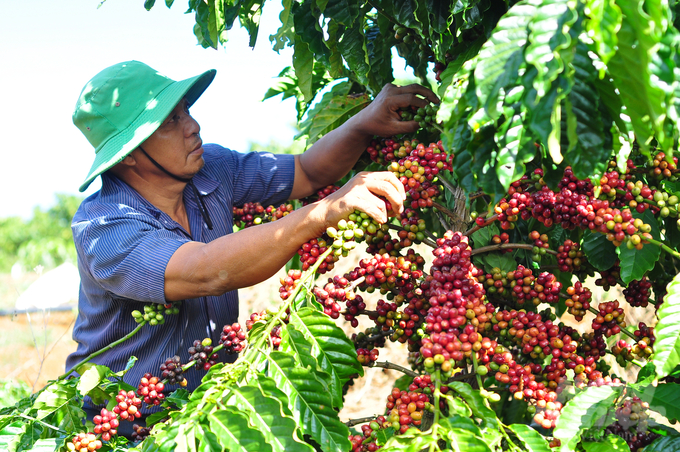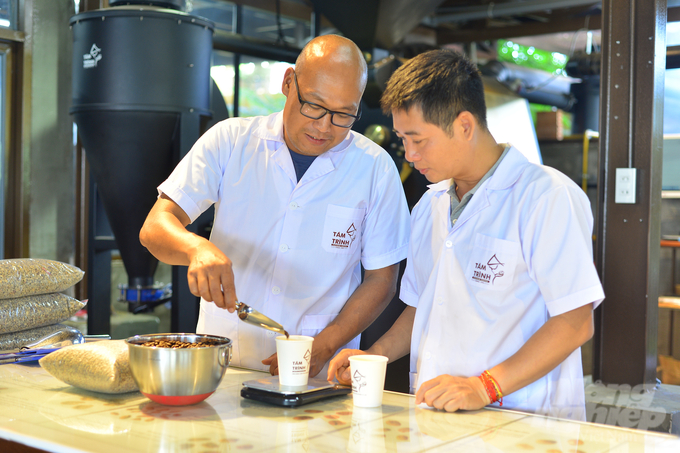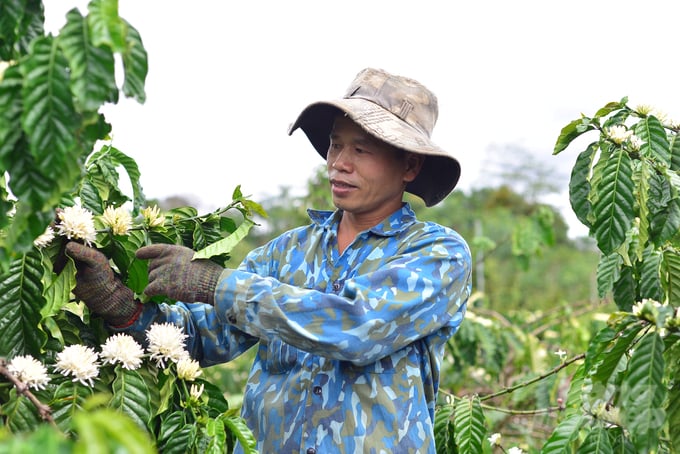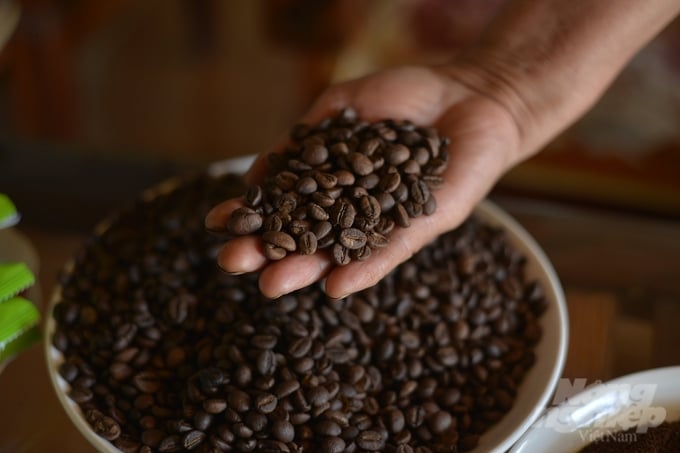November 28, 2025 | 01:23 GMT +7
November 28, 2025 | 01:23 GMT +7
Hotline: 0913.378.918
November 28, 2025 | 01:23 GMT +7
Hotline: 0913.378.918
In Phuc Tho commune (Lam Ha district, Lam Dong), Hoang Van Dat's family is stably cultivating 9 ha of coffee in an area planned for perennial crops. Dat said that the family has been invested in this garden since 2010, each year harvests approximately 20 tons of green coffee kernels. The family's coffee beans are all consumed by agents and processing companies inside and outside the province.
Regarding the EU Deforestation-free Regulation (EUDR), Dat said, “The family initially grasped information through the media and is learning more about EUDR to have a suitable farming method. The family's coffee beans are purchased by units for processing and supplying to domestic and foreign markets, so we must be sure to follow regulations to avoid future risks”.

Lam Dong is the second largest locality in Vietnam (after Dak Lak) in terms of coffee production area with nearly 176,000 ha, the local coffee output is over 600,000 tons/year. Photo: Minh Hau.
As an enterprise that organizes coffee production throughout Lam Dong province with an output of up to 40,000 tons/year supplying to domestic and foreign markets, Tam Trinh Coffee Import-Export Co., Ltd (Gia Lam commune, Lam Ha district) has learned about EUDR and disseminated the information to the production households in the link chain.
Mai Ngoc Dinh, the person in charge of the sustainable coffee production chain of Tam Trinh Co., said that the company currently has a link chain with 3,000 high-quality coffee households in districts of Lam Ha, Lac Duong, Di Linh, Da Lat city and Bao Loc city. In order to ensure quality for domestic and foreign markets, the company regularly organizes training courses on modern production techniques and processes for the people, also sharing knowledge about the latest requirements and regulations from markets so that coffee growers can proactively produce.

Tam Trinh Coffee Import-Export Co., Ltd has a link chain with 3,000 high-quality coffee households. The unit's affiliated coffee gardens have achieved certifications such as 4C and Rainforest Alliance. Photo: Minh Hau.
It is estimated that Lam Dong has 20% of the coffee growing area that has not been measured and granted land use rights (without GPS and polygon). 20% of the coffee area is adjacent/interspersed with forests (mainly planted forests). The province is coordinating with agencies and organizations to review all data to evaluate, plan and come up with a detailed implementation budget plan to ensure the regulations when the EUDR officially comes into effect in 2024.
Developing specialty coffee in line with the planning
Currently, Lam Dong is the second largest locality in Vietnam (after Dak Lak) in terms of coffee production area with approximately 176,000 ha. Coffee Robusta accounts for nearly 159,000 ha, Coffee Arabica accounts for over 16,000 ha, and Coffea Liberica roughly 200 ha. Coffee is mostly grown in Di Linh district with over 45,000 ha.
Facing the new regulation of the EU, the agricultural sector of Lam Dong province has grasped the information about the EUDR and made plans to organize production appropriately. Vu Hong Long, Head of Office of Agriculture and Rural Development of Di Linh district, said that Di Linh district authorities have embarked on implementing solutions in the production organizing. The district focuses on disseminating information to people and businesses on the new market regulations.
“At the end of June, the district's agriculture sector worked with the Delegation of the European Union, organized a survey in coffee growing areas and presented difficulties and obstacles to soon come up with suitable solutions”.
As the locality with the largest coffee area in Lam Dong province, over the years, Di Linh district has implemented many solutions to improve coffee productivity and quality. The district encourages people and businesses to build sustainable coffee production models according to domestic and foreign standards. Special attention is paid to developing specialty coffee in a planned area, enhancing the value of coffee products with high-quality and organic production processes.

The agricultural sector of Lam Dong implements programs to develop high-quality coffee and specialty coffee to meet domestic and foreign market requirements. Photo: Minh Hau.
Meanwhile in Lac Duong district (Lam Dong), coffee has been widely developed since the 1990s and now becomes one of the main crops of Lac Duong agriculture, so the district has clear orientations for development, value enhancement, and market response.
According to an officer of Office of Agriculture and Rural Development of Lac Duong, over the years, coffee has contributed significantly to creating jobs and increasing incomes for people, a commodity which helps the locality increase the total social product, reducing the poverty rate in the area.

In 2022, Lam Dong province's export of green coffee was over 90,000 tons with a total value of over USD 180 million. Photo: Minh Hau.
Lac Duong currently has approximately 5,200 ha of coffee with an estimated business area of 4,700 ha. Aiming to closely follow the EUDR, at the end of May, the district coordinated with the Netherlands Development Organization (SNV) and the Center for Sustainable Rural Development (SRD) to organize discussion and consultation sessions with coffee growers and coffee production and purchasing enterprises in the district, and at the same time disseminate information about EUDR to all people in the area.
Translated by Samuel Pham

(VAN) According to Mr. Vo Minh Thanh, Director of the Tay Ninh Department of Agriculture and Environment, Resolution 57 has created a new development pathway for the locality, shifting from traditional toward modern agriculture.
/2025/11/26/4909-2-154329_878.jpg)
(VAN) Pearl grouper farming in HDPE cages not only delivers economic efficiency but also contributes to protecting the environment, creating jobs, and promoting marine-based experiential tourism.

(VAN) The model of making a living under the forest canopy through the agroforestry system in Van Son commune, Bac Ninh province, is expected to generate an annual income of approximately VND 30 million/ha.

(VAN) Many enterprises in Can Tho are harnessing natural energy and reducing greenhouse gas emissions in their production processes, thereby contributing to the promotion of a sustainable green transition.
/2025/11/24/3536-2-112800_176.jpg)
(VAN) Dong Nai now has tens of thousands of hectares of forests certified for sustainable management, and this area will continue to be expanded in the coming period.

(VAN) Vinh Ha hamlet (Dai Xuyen commune, Hanoi) is shifting away from small-scale farming as households adopt bioscurity into their breeder chicken models.

(VAN) Heavy rains make aquatic species more vulnerable to disease. Proactive water management and high-tech systems help farmers prevent outbreaks and protect yields.